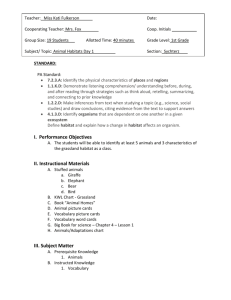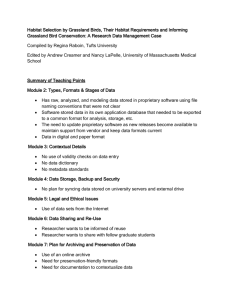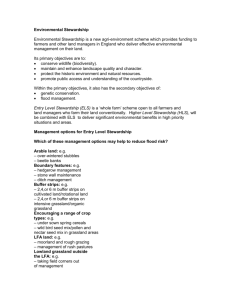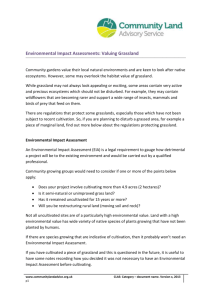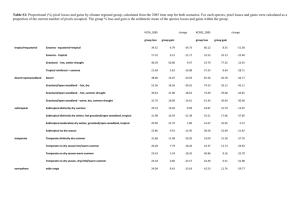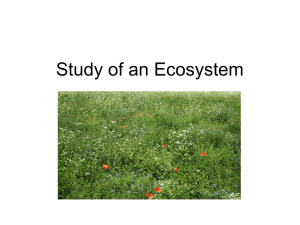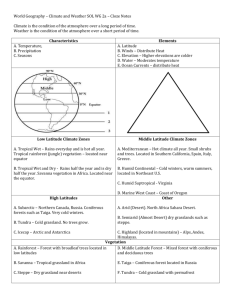Grassland Bird Conservation Design
advertisement
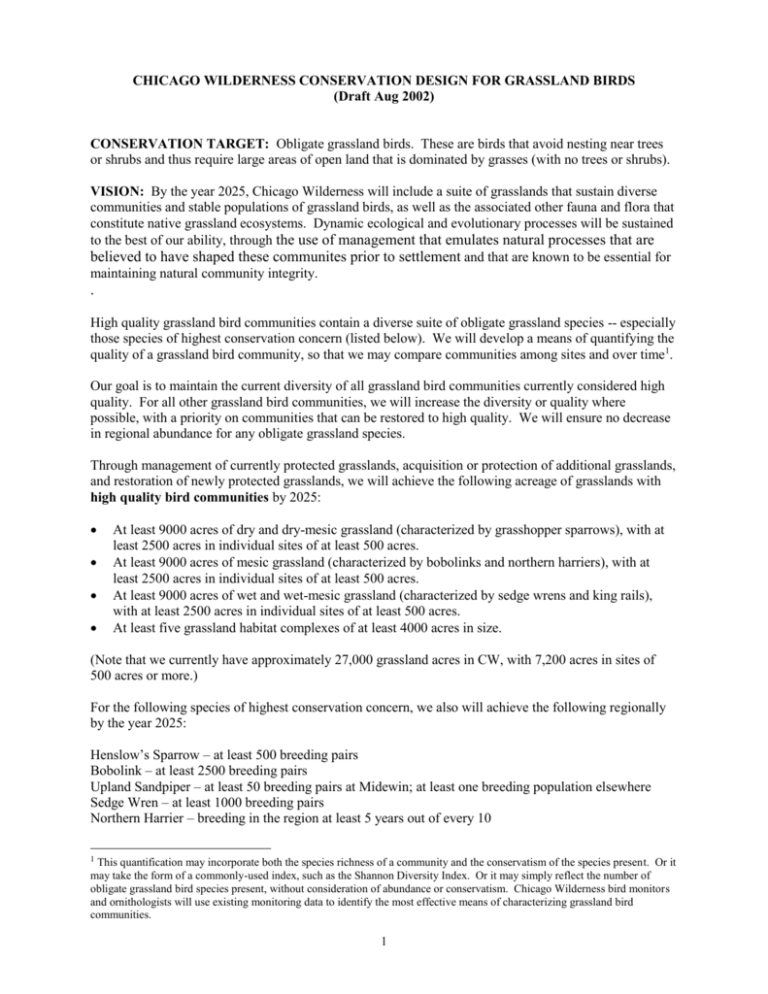
CHICAGO WILDERNESS CONSERVATION DESIGN FOR GRASSLAND BIRDS (Draft Aug 2002) CONSERVATION TARGET: Obligate grassland birds. These are birds that avoid nesting near trees or shrubs and thus require large areas of open land that is dominated by grasses (with no trees or shrubs). VISION: By the year 2025, Chicago Wilderness will include a suite of grasslands that sustain diverse communities and stable populations of grassland birds, as well as the associated other fauna and flora that constitute native grassland ecosystems. Dynamic ecological and evolutionary processes will be sustained to the best of our ability, through the use of management that emulates natural processes that are believed to have shaped these communites prior to settlement and that are known to be essential for maintaining natural community integrity. . High quality grassland bird communities contain a diverse suite of obligate grassland species -- especially those species of highest conservation concern (listed below). We will develop a means of quantifying the quality of a grassland bird community, so that we may compare communities among sites and over time1. Our goal is to maintain the current diversity of all grassland bird communities currently considered high quality. For all other grassland bird communities, we will increase the diversity or quality where possible, with a priority on communities that can be restored to high quality. We will ensure no decrease in regional abundance for any obligate grassland species. Through management of currently protected grasslands, acquisition or protection of additional grasslands, and restoration of newly protected grasslands, we will achieve the following acreage of grasslands with high quality bird communities by 2025: At least 9000 acres of dry and dry-mesic grassland (characterized by grasshopper sparrows), with at least 2500 acres in individual sites of at least 500 acres. At least 9000 acres of mesic grassland (characterized by bobolinks and northern harriers), with at least 2500 acres in individual sites of at least 500 acres. At least 9000 acres of wet and wet-mesic grassland (characterized by sedge wrens and king rails), with at least 2500 acres in individual sites of at least 500 acres. At least five grassland habitat complexes of at least 4000 acres in size. (Note that we currently have approximately 27,000 grassland acres in CW, with 7,200 acres in sites of 500 acres or more.) For the following species of highest conservation concern, we also will achieve the following regionally by the year 2025: Henslow’s Sparrow – at least 500 breeding pairs Bobolink – at least 2500 breeding pairs Upland Sandpiper – at least 50 breeding pairs at Midewin; at least one breeding population elsewhere Sedge Wren – at least 1000 breeding pairs Northern Harrier – breeding in the region at least 5 years out of every 10 1 This quantification may incorporate both the species richness of a community and the conservatism of the species present. Or it may take the form of a commonly-used index, such as the Shannon Diversity Index. Or it may simply reflect the number of obligate grassland bird species present, without consideration of abundance or conservatism. Chicago Wilderness bird monitors and ornithologists will use existing monitoring data to identify the most effective means of characterizing grassland bird communities. 1 Grasshopper Sparrow – at least 2500 breeding pairs King Rail – at least 20 breeding pairs American Bittern – at least 5 regular breeding pairs Sandhill Crane – at least 200 breeding pairs Common Snipe – breeding in the region at least 5 years out of every 10 List of obligate grassland birds (target species for Grassland Bird Conservation Design): northern harrier upland sandpiper short-eared owl sedge wren savannah sparrow grasshopper sparrow Henslow's sparrow dickcissel bobolink eastern meadowlark western meadowlark greater prairie chicken american bittern king rail sandhill crane common snipe black rail Wilson’s phalarope Loggerhead shrike, bell's vireo, field sparrow, willow flycatcher, yellow-breasted chat, and orchard oriole are important species that use grassland with shrubs. Their habitat needs are not specifically addressed in the Conservation Design for obligate grassland birds but should be addressed in a separate Conservation Design for shrubby grassland birds. For the current Conservation Design, the habitat needs of shrubby grassland birds should be kept in mind in those instances in which it is impossible to restore all or part of a grassland site for obligate grassland birds (for example, if a site were too small to support obligate grassland birds and had no chance of being enlarged, it might be better managed for shrubby grassland birds). Please see Appendix B for a list of birds that use grasslands but that are not included in the list of target species for this Conservation Design. 2 SUMMARY OF VISION: QUANTITATIVE GOALS: Year 2005 2010 2015 2020 2025 Monitor 150 200 300 300 300 Improve 10 25 75 125 150 High quality 5 15 50 75 100 Regional abundance 0 0 0 0 0 Large Acreage 2500 4000 6000 7500 9000 Sites 500 1000 1500 2000 2500 Habitat 1 2 3 4 5 Species 2 4 8 10 Bold face type signifies the highest priority goals. Monitor = The number of grassland sites2 of at least 50 acre size where grassland birds are being consistently monitored. Monitoring of larger sites generally should be higher priority and more extensive than that of smaller sites. Improve = The number of monitored grassland sites where the quality of the grassland bird community has increased from its baseline value or, where the baseline value is high, it has remained high. High quality = The number of monitored grassland sites with a high quality grassland bird community. Regional abundance = The number of obligate grassland species whose regional abundance has shown three successive years of decline compared to current numbers. Acreage = The number of grassland acres of each subtype listed on page 1 that contain high quality grassland bird communities. Large Sites = The number of acres of each subtype listed on page 1, represented by moderately large (>500 acres) sites and containing high quality grassland bird communities. Habitat = The number of large (>4000 acres), diverse grassland habitat complexes with protected status and active management and monitoring programs. See the following pages for specific management recommendations. Species = The number of species of conservation priority whose recovery goals (p.1) have been met. EVALUATION OF OUTCOME: If we fail to meet our Large Sites or Habitat goals in any specified year, then we should establish Chicago Wilderness task forces that would work to help land agencies protect the land necessary to establish large sites or habitat complexes, or help increase resources for managing or monitoring large complexes that already have been protected. 2 Sites are defined as ecological units that are distinguished on a coarse scale by community type. In most cases, CD site boundaries will correspond to the boundaries recognized by individual land owners. However, a single CD site may have more than one landowner, or a single landowner’s site may include several different CD sites. 3 If we fail to meet our Monitoring goal in any specified year, then we should increase the regional resources devoted to monitoring programs. If we fail to meet any of the other goals in any specified year, then we should increase the regional resources devoted to habitat restoration and land protection, as outlined on the following pages. If specific research or monitoring projects demonstrate that our current restoration strategies are ineffective, then we should alter our strategies toward those that have been shown to be more effective. The Conservation Design for Grassland Birds will receive periodic, regular review by scientists, land managers, and other experts within and outside of Chicago Wilderness. The goals stated throughout this CD may change qualitatively or quantitatively, as we obtain more monitoring data and conduct more research to better understand the restoration ecology of grassland bird habitat and the status of grassland birds within Chicago Wilderness. The numbers given here represent the best expert and professional judgement of the region’s birders and ornithologists and are an appropriate place to begin focusing our conservation efforts. 4 THREATS TO GRASSLAND BIRDS Summary of Threats and Management Goals: 1. THREAT: Habitat degradation and succession MANAGEMENT: Reduce groundcover by woody shrubs and trees, through prescribed fire and invasive species control. 2. THREAT: Loss of breeding habitat from early mowing MANAGEMENT: Reduce or eliminate the practice of mowing grasslands before August 1. 3. THREAT: Loss of large grasslands due to fragmentation, development, and succession MANAGEMENT: Remove fencerows, prevent development within grassland habitat, and increase the size of existing grassland habitat. 4. THREAT: Herbaceous species composition that does not benefit grassland birds. MANAGEMENT: Determine the native herbaceous species assemblages that are most beneficial to grassland birds and increase the regional acreage planted with these assemblages. 5 THREAT #1 Stress: Habitat degradation Source: Brush invasion General goal: Reduce groundcover by woody shrubs and trees. Specific goal: By 2025, 100% of existing and potential grassland sites have in place written, approved, active plans to address invasive woody species and prescribed fire management. Ground cover by woody plants has been maintained or reduced to 10% or less of total groundcover at 80% of these sites. The habitat needs of shrubby grassland birds should be kept in mind in those instances in which it is impossible to restore a grassland site for obligate grassland birds. Management strategy: (a) Develop prescribed fire management plans and invasive woody species control plans for all identified sites, and implement the plans. (b) Use physical (cutting), chemical (herbiciding), and other (fire, etc.) means to clear invasive trees and shrubs (these may include both native and non-native species) and ensure that cleared invasives do not return. (c) Burn at least 25% of total grassland acreage every year, with no area burned twice in successive years. On the majority of sites, a given area should only rarely be burned twice within a given four year period. Mowing in August may be a substitute for burning when needed. A diversity of burning regimes should be maintained within and among grassland sites. Immediate actions: In 2003: (a) Implement invasive species control plans at one new site, or expand control activities at one site already being managed for invasive woody species. (b) Burn approximately 25% of the area in at least 20% of the target sites. INDICATORS OF PROGRESS: GOALS: Year 2005 2010 2015 2020 2025 Planning 25% 50% 75% 100% 100% Invasives 10% 20% 30% 60% 80% Burning 50% 70% 80% 80% 80% Planning = Percent of grassland sites that have written, approved, active plans to address invasive woody species and prescribed fire management. Invasives = Percent of grassland sites where invasive woody plant coverage has been reduced to 10% or less. Burning = Percent of identified sites where 25% of the acreage has been burned in four of the five previous years, consistent with the management strategy outlined above. 6 EVALUATION OF OUTCOME: If we fail to meet our Planning goal in 2005, then Chicago Wilderness should form a task force to examine the barriers to planning (lack of resources, knowledge, research, etc.) and work with individual land agencies to help them overcome these barriers so that we meet our Planning goal in 2010. If we fail to meet our Invasives or Burning goals in 2005, then Chicago Wilderness and individual land agences should secure and devote increased resources to support the expansion of management actions as outlined above. 7 THREAT #2 Stress: Loss of breeding habitat Source: Early mowing of hayfields General goal: Where possible, eliminate the practice of mowing of hayfields before August 1 on existing and potential grassland bird breeding areas. Specific goal: By 2025, the practice of mowing hayfields before August 1 has been eliminated in the Chicago Wilderness region, except for those sites where such elimination would result in the conversion of hayfields to row crops or other use inimical to birds. For the latter sites, mowing after July 1 would be an acceptable compromise. Management strategy: Ensure that no hayfields or grasslands are mowed prior to July 1, with August 1 the preferred earliest mowing date. Immediate actions: In 2003, ask the mowers at all potential or existing grassland bird sites to agree to mow after August 1. If this schedule is impossible, ask them to mow after July 1. INDICATORS OF PROGRESS: GOALS: Year Mowing 2003 50% 2005 0% 2010 0% 2015 0% 2025 0% Mowing = Percentage of identified grassland bird sites that are mowed before August 1 (where possible) or July 1 (where necessary). EVALUATION OF OUTCOME: If we fail to meet our mowing goal in any year, then determine why early mowing occurred, what, if any, specific challenges or obstacles exist at the sites in question, and what can be done to help ensure no early mowing in the future. 8 THREAT #3 Stress: Loss of sufficiently large areas for bird habitat Source: Habitat fragmentation by fencerows; conversion of hayfields and grazing land to development or shrubland. General goal: Increase average contiguous grassland or prairie habitat size in the region by removing existing fencerows separating large grassland areas, preventing all development in large grassland habitat areas, and increasing the size of existing grasslands where possible. Specific goal: By 2025, 100% of the region’s grassland sites have in place written, approved, active plans to address fragmentation, and 80% have begun implementing these plans. Also by 2025, 50% of existing grassland sites with high quality bird communities have increased in size, and the number of moderately large (>500 acre) sites in the region has increased. Management strategy: (a) Develop and approve written plans to address fragmentation, and implement the plans. (b) Remove hedgerows and burn, mow, or herbicide reprouting shrubs to ensure that fencerows do not return. (c) At sites identified as existing or potential habitat to be managed for grassland birds, prevent development on as many as possible of those not currently protected from development, using easements, acquisition, or other strategies. (d) Acquire additional acreage of protected grassland adjacent to already protected sites, and develop a written, approved plan in every county to address land acquisition or easements. Immediate actions: In 2003: (a) Begin planning process to address fragmentation at 10% of sites. (b) Remove hedgerows separating intact grasslands at two sites in the region. (c) Identify all existing or potential grasslands that are in need of protection through acquisition, easements, or other measures, especially for land adjacent to already protected sites. (d) Begin planning process to address land acquisition and conservation easements. INDICATORS OF PROGRESS: GOALS: Year Planning 2005 25% 2010 50% 2015 75% 2020 100% 2025 100% Hedgerows 20% 40% 50% 70% 80% Acquisition 10% 20% 30% 40% 50% Large Sites 1500 3000 4500 6000 7500 Fundraising 10 Planning = Percent of identified sites that have written, approved, active plans to address fragmentation. Hedgerows = Percent of identified sites where hedgerows have been permanently removed. Acquisition = Percent of sites with high quality bird communities that have been increased in size. Large sites = Regional grassland acreage represented by moderately large (>500 acre) sites. 9 Fundraising = Number of Chicago Wilderness counties with written, approved plans to address land acquisition or easements. EVALUATION OF OUTCOME: If we fail to meet our Planning or Fundraising goal in 2005, then Chicago Wilderness should form a task force to examine the barriers to planning or fundraising (lack of resources, knowledge, research, etc.) and work with individual land agencies to help them overcome these barriers so that we meet our Planning and Fundraising goals in 2010. If we fail to meet our Acquisition or Large Sites goal in 2005, then Chicago Wilderness should secure increased resources for land acquisition or protection, to be distributed to or secured by individual land agencies, so that we meet our Acquisition and Large Sites goals in 2010. If we fail to meet our Hedgerows goal in 2005, then Chicago Wilderness and individual land agences should secure and devote increased resources to support the expansion of management actions as outlined above. 10 THREAT #4 Stress: Herbaceous species composition that does not benefit grassland birds Source: Historical farming; lack of seeding by natives; invasive species; plantings that are nearly monocultures of tall grasses like Indian grass and big bluestem General goal: Determine the native herbaceous species assemblages that are most beneficial to grassland birds and increase the regional acreage planted with these assemblages. Specific goal: Conduct research to determine the native herbaceous assemblages that are most beneficial to grassland birds. By 2025, increase the regional acreage planted with these assemblages by 50%. Management strategy: Plant or maintain different native herbaceous assemblages at specified sites, and monitor birds to determine which plant assemblages provide the most benefit to grassland birds. Immediate actions: In 2003, identify moderately large (>500 acres) grassland sites where ground cover by native herbaceous species is high, and develop written research and monitoring plans to determine which plant assemblages are most beneficial to grassland birds. Also identify additional native plant assemblages that should be planted at other sites for comparison of effects on grassland birds. INDICATORS OF PROGRESS: GOALS: Year 2005 2010 2015 2020 2025 Research 10% 20% 30% 40% 50% Habitat 10% 20% 30% 40% 50% Research = Percent of moderately large (>500 acres) sites that have written, approved, active plans to address research and monitoring of the effects of different plant assemblages on grassland birds. Habitat = Percent increase in grassland acreage composed of native prairie plants, with the composition of these plants reflecting the results of research described above. EVALUATION OF OUTCOME: If we fail to meet our Research goal in 2005, Chicago Wilderness should devote increased resources to the research task force. The task force should work to increase funding for priority research projects and increase the incentives to researchers who focus on priority research, so that we meet our Research goal in 2010. If we fail to meet our Habitat goal in 2005, the Chicago Wilderness research task force should work to increase the availability of research results to land managers. This work might include the hosting of a research conference and the continued development of a regional database for research and monitoring data. It also might include garnering increased resources for land agencies who cannot implement new management techniques due to limited resources, or working to increase flexibility within land agency beaurocracies. 11 Appendix A: Research and Inventory Questions for Chicago Wilderness RESEARCH QUESTIONS: 1. What is the native planting mix that is most beneficial to grassland birds? 2. How do other taxa fare with this planting mix, compared to other mixes? 3. What burning rotation will maximize the species numbers and diversity of grassland birds in the Chicago Wilderness region? 4. What is the effect on grassland bird breeding of mowing before August 1? 5. What is the earliest date at which mowing does not adversely affect grassland bird breeding? 6. What is the effect of removing hedgerows on grassland bird communities (i.e., both grasslanddependent birds and birds that use the hedgerows)? INVENTORY QUESTIONS: 1. What is the current mean diversity index for grassland birds in the Chicago Wilderness region, and how do indices compare among sites? What are these values after 5 and 10 years? 2. Identify and map existing grassland bird sites, and calculate the full acreage of each site and the acreage of each grassland fragment on site. 3. Determine how many acres of existing grassland habitat currently contain tallgrass monocultures, and how many contain more diverse mixtures more beneficial to grassland birds. 4. Determine burn history for the sites with greatest current grassland bird indices. 5. Determine which grassland sites are mowed prior to August 1. 12 Appendix B : Birds that use grasslands but that are not included on the list of targets for the Grassland Bird Conservation Design. NOT OBLIGATE: horned lark and vesper sparrow (use farm fields) american kestrel brown-headed cowbird killdeer red-winged blackbird woodcock WETLAND: swamp sparrow SHRUB USERS NOT OF CONSERVATION SIGNIFICANCE: mourning dove song sparrow SAVANNA BIRD: eastern bluebird BARELY A PART OF CW AVIFAUNA, AND NOT A TRUE CONSERVATION TARGET FOR CW: brewer's blackbird NOT REALISTICALLY RESTORABLE WITHIN THE TIME FRAME OF THIS CONSERVATION DESIGN: sharp-tailed grouse long-billed curlew LeConte's sparrow 13


